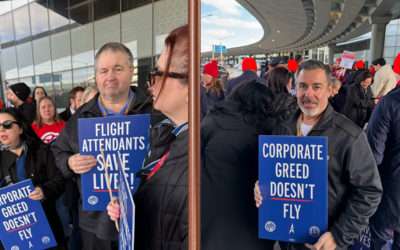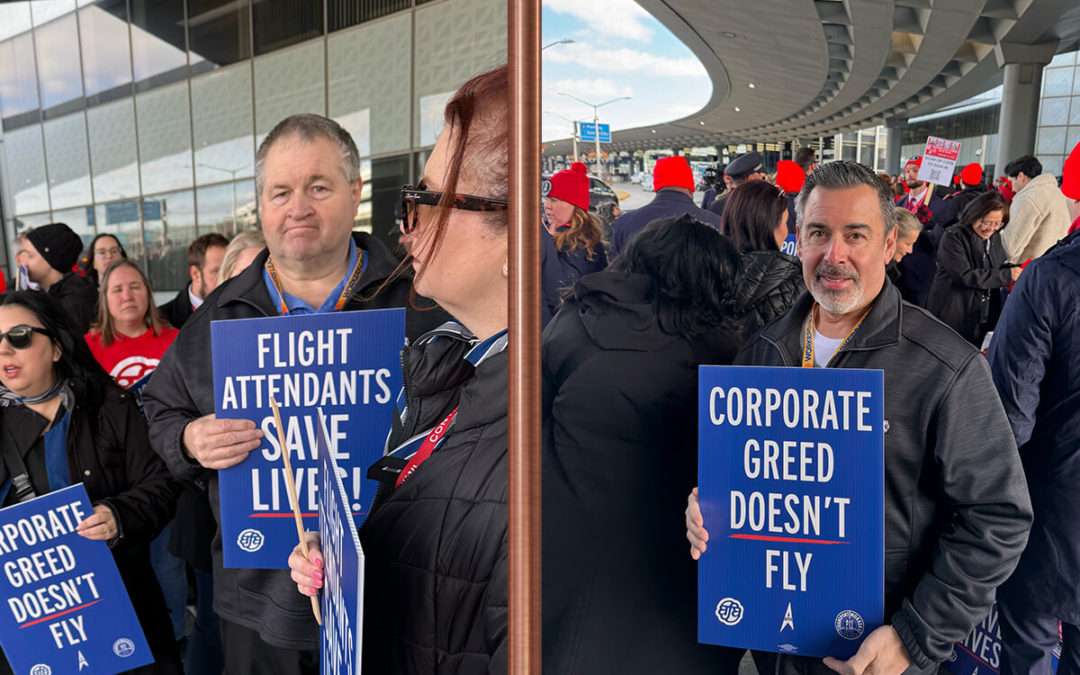Machinists Union Stands in Solidarity with Flight Attendants in Nationwide Day of ActionPictured: Assistant General Chairs Erik Stenberg (left) and Mike Cyscon.In a display of solidarity, members of the Machinists Union joined flight attendants in nationwide rallies...

Hurricane Idalia: Emergency Resources

Hurricane Idalia Emergency Resources
Union Resources
Contact your Assistant General Chair or Local Grievance Committee for help accessing the IAM Disaster Relief Fund.
Airports are likely to have suffered damage as a result of the storm. If you see any safety-related issues when returning to work, please complete a safety report (GSAP, GSIP, etc.)
Safety Page
All IAM members can obtain confidential help through the IAM Employee/Member Assistance Program. Services include but are not limited to addictions, mental health, stress, depression, and financial hardship.
You can reach the confidential IAM Assistance Helpline by calling 301-335-0735 or emailing iameap@iamaw.org.
As an IAM member, you could also be eligible for a $500 disaster relief grant through the Union Plus Disaster Relief Grant program.
Mobile Apps
Florida Storms – Florida Public Radio Emergency Network Google Play iTunes
Florida 511 – Get up-to-the-minute, real-time traffic conditions and incident information for the State of Florida with Florida 511.
FEMA – mobile app
Red Cross – mobile apps
Everbridge – mobile apps
Gas Buddy – Gas station availability
Traffic
Florida 511 – Get up-to-the-minute, real-time traffic conditions and incident information for the State of Florida with Florida 511.
Florida Highway Patrol – Florida Highway Patrol Live Traffic Crash and Road Condition Report. Reports are updated every five minutes. Incidents located within city limits also may not show on the map since it is not common practice for FHP to work incidents inside city limits.
Florida Traffic – Traffic incidents and conditions from Florida 511 and Florida Highway Patrol brought to you by Florida State Emergency Response Team Geographic Information Systems.
Evacuation Information
All Florida coastal counties and counties are susceptible to storm surges, and most have designated evacuation zones.
Mapping tool: Allows those in the storm’s path to search by address and determine if you are in a designated evacuation zone.
Evacuation Zones – to determine if you are in a designated evacuation zone
Evacuation Orders: View Florida County evacuation orders.
Read More About Evacuation Zones – learn more about designated evacuation zones, which counties have them and which don’t, how flood zones are factored into evacuations, and evacuation orders.
Shelter Status and Openings
Please go to Summary Shelter Information for currently open general and special needs shelters within the State of Florida.
For information from your county Emergency Management program regarding shelter preparedness and lists of potential shelters that may be opened, please visit the Shelter Information Index and choose your county.
View Open Shelters on a map.
Special Needs Assistance
If you know or care for an individual with access or functional needs, such as a medical condition that requires assistance but not hospitalization, it is important that you pre-register with the Florida Special Needs Shelter Registry.
For more Special Needs Sheltering Information, here.
State Assistance Information Hotline
This toll-free hotline is activated to provide additional resources to help Floridians receive accurate & up-to-date information regarding Hurricane Idalia.
State Assistance Information Line: 1-800-342-3557
Report Fraud or Price Gouging
- FEMA employees will always have an official ID
- Don’t trust anyone who offers financial help & asks for money or personal info.
- Always talk with someone you trust.
Ways to Report Fraud to FEMA
- Email: StopFEMAfraud@Fema.dhs.gov
- Call: 1-866-223-0814
- Fax: 202-212-4926
For more information, visit fema.gov/disaster-fraud
Report Price Gouging in Florida
- Call: 1-866-966-7226
Emergency Planning
While living in and visiting Florida offers many benefits and advantages, it is important to keep in mind severe weather hazards and potential threats. Every family and business should have predefined emergency plans and always keep an emergency supply kit ready and stocked.
Each Florida county has a designated emergency management program, and residents, businesses, and visitors should also visit their county’s emergency management for the most up-to-date and locally significant information.
Access and Functional Needs
Over 1,500 Flights Canceled Due to Hurricane Idalia
IAMAW141 | 30 August, 2023
By Wednesday morning, Hurricane Idalia had severely impacted the Gulf Coast Big Bend region, resulting in the cancellation of over 1,500 flights and the delay of at least 1,000 more.
The storm was the worst to hit the region in more than 120 years.
The Federal Aviation Authority has announced that multiple airports, such as Tampa, St. Pete-Clearwater, Sarasota, and Tallahassee, are shut down. They might reopen on Thursday, based on the amount of damage the storm caused.
Aviation tracking website FlightAware data shows Southwest Airlines being the hardest hit, with 200 canceled flights. American, Delta and United Airlines saw 200 additional delays and 300 cancellations at 9:00 a.m.
Passengers flying to airports in the path of Hurricane Idalia have been notified by major airlines, including Delta, JetBlue, Southwest, and United. These airlines offer free booking changes within a specific time frame to accommodate the hurricane’s impact on travel plans.
The National Hurricane Center reported that just before 8 a.m. ET, Idalia arrived at Keaton Beach in Florida’s Big Bend region as a Category 3 storm, with maximum sustained winds of 125 mph and even higher gusts.
In preparation for potential impacts from Invest 93L, Governor Ron DeSantis of Florida has declared a state of emergency for 33 counties. This order enables state officials to provide necessary resources to any affected areas.
Florida Governor Ron DeSantis declared a state of emergency for 33 counties in the hours leading up to Idalia’s landfall. The order allows state officials to make critical resources available to areas that the storm may impact.
Florida is home to thousands of Machinists Union Members centered around the state’s airports.
Departments >>
Airlines and Contracts >>
ORG Chart and Local Lodges >>
IAM141 Admin >>
District Events >>
Union Forms Library >>



















